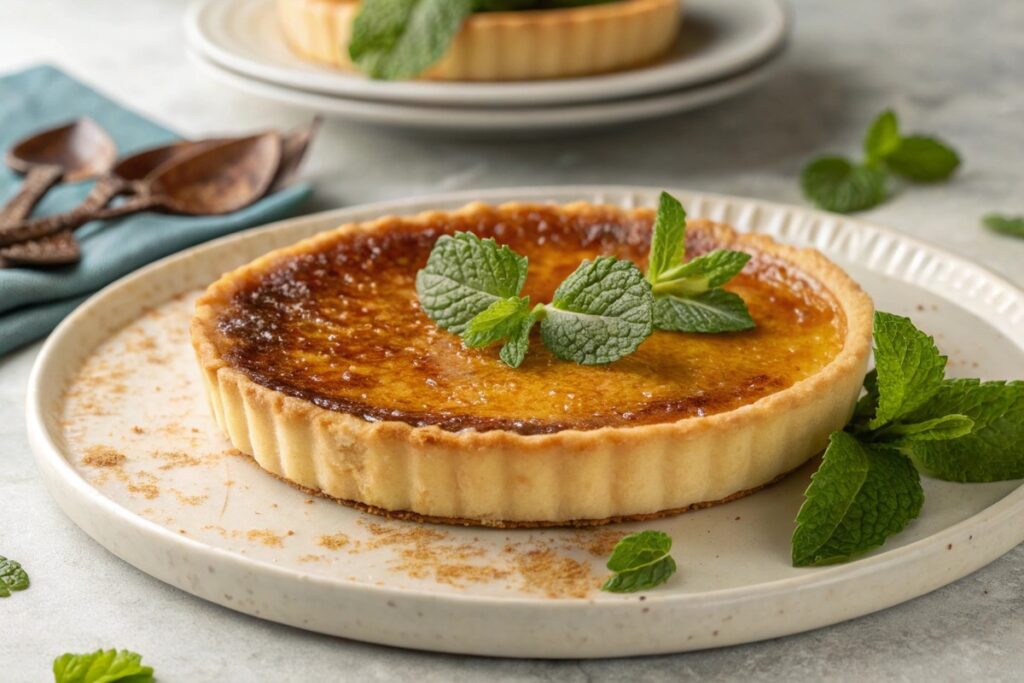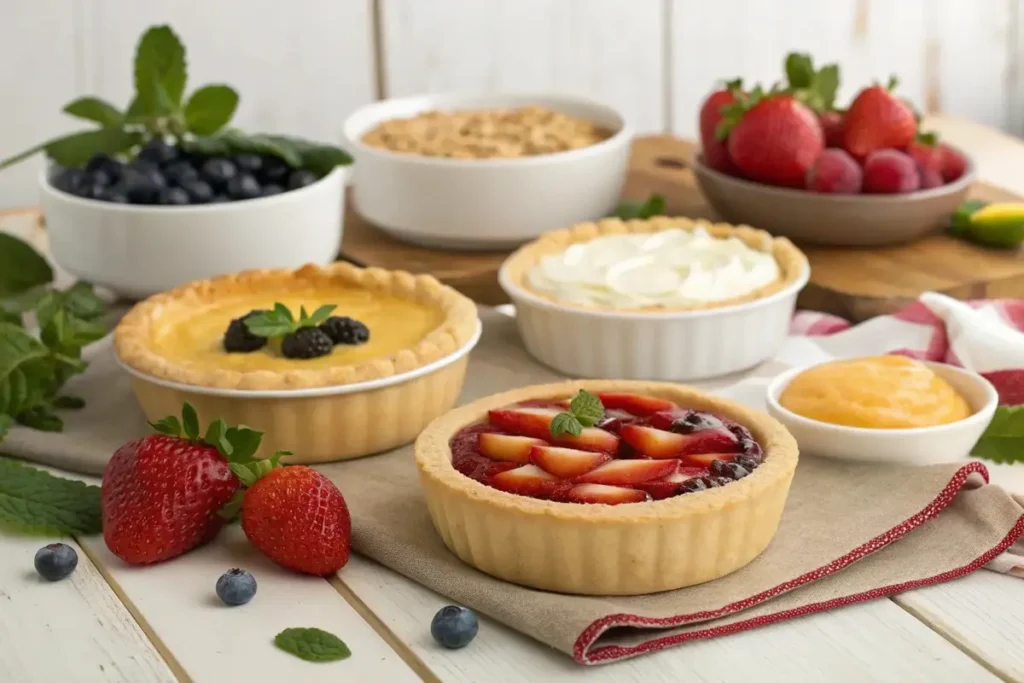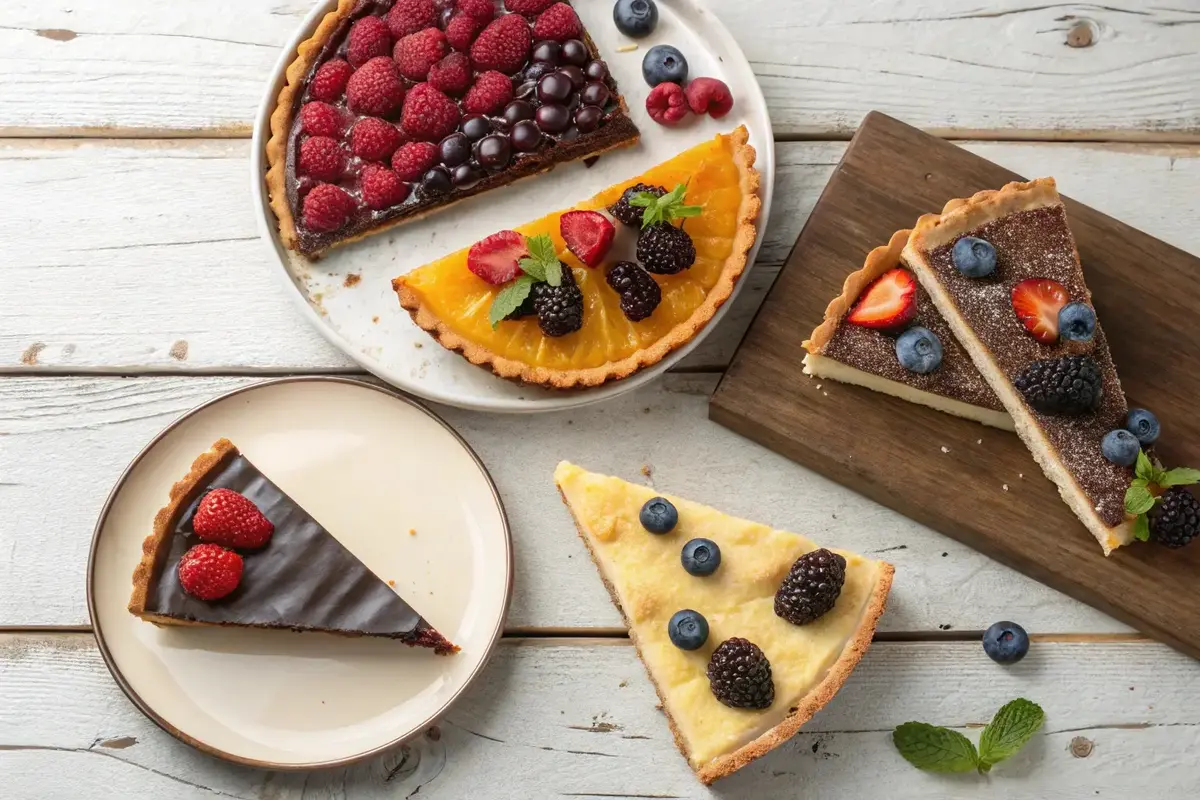Introduction
Pies and tarts are versatile, timeless desserts that come in countless variations. Whether sweet or savory, their fillings define their essence and create a world of flavor possibilities. But have you ever wondered, what are the 4 types of filling for pies and tarts? This article breaks down the essential types—fruit, custard, cream, and savory—while diving into their characteristics, preparation tips, and popular recipes. By the end, you’ll be ready to explore the art of crafting perfect pies and tarts for any occasion.
Part 1: Understanding the Basics of Pie and Tart Fillings
What Are Pie and Tart Fillings?
The filling is the heart of any pie or tart. It defines the taste, texture, and appeal of these beloved pastries. Fillings can be as simple as fresh fruit or as complex as a layered custard infused with spices.
Pie and tart fillings generally fall into two broad categories: sweet and savory. Sweet fillings are more common in desserts, while savory fillings are popular for hearty meals. These distinctions ensure pies and tarts can suit a wide range of preferences and occasions.
An Overview of the Four Types of Fillings
Let’s outline the four primary types of fillings, each offering unique characteristics:
- Fruit Fillings: Fresh, cooked, or preserved fruits form the base of these sweet and tangy creations.
- Custard Fillings: A smooth mixture of eggs, cream, and sugar baked to perfection for a creamy texture.
- Cream Fillings: Luxuriously rich and often topped with whipped cream, these are decadent options for dessert lovers.
- Savory Fillings: Featuring ingredients like vegetables, meat, and cheese, savory fillings transform pies and tarts into satisfying meals.
Part 3: Fruit Fillings for Pies and Tarts
The Classic Fruit Filling
Fruit fillings are among the most beloved types for pies and tarts. Their natural sweetness and tanginess bring vibrancy to desserts, while their versatility allows bakers to experiment with countless combinations.
Popular Fruits for Fillings
Fruit fillings can be made from a variety of fruits, either individually or in combination:
- Apples: A quintessential choice for pies, offering a balance of sweetness and tartness. Granny Smith and Honeycrisp are popular options.
- Berries: Blueberries, strawberries, raspberries, and blackberries bring bright flavors and vibrant colors.
- Cherries: Perfect for creating a rich and tangy filling that pairs well with a buttery crust.
- Peaches: Sweet and juicy, peaches are ideal for summer tarts and galettes.
Each fruit lends its unique flavor and texture, making fruit fillings a versatile option for bakers.
Preparation Techniques
Preparing fruit fillings requires attention to detail to achieve the desired consistency and flavor.
- Cooking the Fruit: Cooking fruits like apples or berries with sugar and spices enhances their flavor and ensures a cohesive filling. A thickener, such as cornstarch or tapioca, is often added to bind the juices.
- Using Raw Fruit: Some fruits, like peaches or strawberries, can be used raw for a fresher taste. They’re typically combined with sugar and lemon juice before layering into the crust.
- Spices and Flavor Enhancers: Spices like cinnamon, nutmeg, and cloves, as well as a splash of vanilla or citrus zest, elevate the flavor profile of fruit fillings.
Seasonal Variations
The beauty of fruit fillings lies in their adaptability to seasonal produce:
- Spring and Summer: Strawberries, blueberries, peaches, and cherries are abundant during warmer months, creating light and refreshing fillings.
- Fall and Winter: Apples, pears, and cranberries are perfect for cozy, spiced pies during cooler months. These fruits pair beautifully with cinnamon, ginger, and nutmeg.
Choosing fruits based on their seasonal availability ensures maximum flavor and freshness.
Signature Recipes with Fruit Fillings
- Apple Pie: A classic dessert made with spiced apples and a buttery, flaky crust.
- Blueberry Tart: Vibrant and sweet, often topped with a glaze to enhance the berries’ natural shine.
- Peach Galette: A rustic, freeform tart that highlights the juicy sweetness of ripe peaches.
Part 4: Custard Fillings for Pies and Tarts
What Are Custard Fillings?
Custard fillings are smooth and creamy, made from a mixture of eggs, milk or cream, and sugar. Baked slowly, these fillings achieve a rich and velvety texture that’s both indulgent and satisfying.
Key Ingredients
The foundation of custard fillings lies in a few essential ingredients:
- Eggs: Provide structure and help set the filling.
- Milk or Cream: Adds richness and creaminess.
- Sugar: Balances the flavor and sweetness.
- Flavorings: Ingredients like vanilla, citrus zest, or spices can enhance the custard’s taste.
Popular Types of Custard Fillings
Custard fillings appear in a variety of beloved pies and tarts:
- Pumpkin Pie: A fall favorite made with spiced pumpkin puree and a creamy custard base.
- Sweet Potato Pie: Similar to pumpkin pie but with a distinct earthiness from the sweet potato.
- Lemon Tart: A tangy and refreshing dessert with a smooth custard filling.
Texture and Flavor Profile
Custard fillings are celebrated for their:
- Smoothness: A well-made custard is creamy without lumps.
- Richness: The combination of eggs and cream creates a luxurious texture.
- Balanced Sweetness: Neither overly sweet nor bland, allowing the added flavors to shine.
Tips for Perfect Custard Fillings
- Bake at a Low Temperature: Custards need gentle heat to set without curdling.
- Strain the Mixture: Pour the filling through a fine-mesh sieve before baking to remove any lumps.
- Avoid Overbaking: Custards continue to set as they cool, so remove them from the oven when the center is slightly wobbly.

Part 5: Cream Fillings for Pies and Tarts
Cream-Based Fillings for Decadence
Cream fillings are luxurious, rich, and smooth, making them a favorite for indulgent desserts. These fillings are typically chilled rather than baked, creating a refreshing contrast to warm pies or tarts.
Ingredients and Preparation
Cream fillings are straightforward yet require precision for the perfect consistency:
- Heavy Cream: The foundation of cream fillings, providing a rich and velvety texture.
- Sugar: Adds sweetness to balance the richness of the cream.
- Gelatin: Often used to stabilize the filling and ensure it sets properly. For vegetarians, agar-agar can be used as a substitute.
- Flavorings: Chocolate, vanilla, coconut, or fruit purees are common for adding depth to the filling.
Preparation involves whipping heavy cream to soft peaks and folding in the other ingredients, ensuring a light and airy texture.
Examples of Cream Pies and Tarts
Cream-based pies and tarts are versatile and perfect for various occasions:
- Banana Cream Pie: Features a creamy vanilla custard filling layered with fresh bananas and topped with whipped cream.
- Chocolate Cream Pie: A decadent dessert made with rich chocolate filling and a crisp crust.
- Coconut Cream Tart: Combines creamy coconut filling with toasted coconut for a tropical flair.
Toppings for Cream Pies
Enhancing cream pies with creative toppings adds both flavor and visual appeal:
- Whipped Cream: Light and fluffy, it complements the richness of cream fillings.
- Grated Chocolate: Adds texture and an extra layer of indulgence to chocolate-based pies.
- Toasted Coconut: Provides a crunchy contrast and amplifies the tropical flavor in coconut pies.
Part 6: Savory Fillings for Pies and Tarts
The Rise of Savory Pies and Tarts
Savory pies and tarts have gained popularity as hearty main dishes and versatile appetizers. Packed with robust flavors, they offer a satisfying alternative to sweet pastries.
Ingredients Commonly Used in Savory Fillings
Savory fillings combine a variety of ingredients for bold, comforting flavors:
- Meats: Chicken, beef, pork, or seafood provide protein-rich bases.
- Cheeses: Gruyère, cheddar, and ricotta are popular choices for adding creaminess.
- Vegetables: Spinach, mushrooms, tomatoes, and leeks are common for vegetarian or balanced fillings.
- Eggs: Often used in quiches to create a custard-like consistency.
Iconic Savory Pies and Tarts
Some classic savory pies and tarts showcase the versatility of these fillings:
- Chicken Pot Pie: Features tender chicken, peas, and carrots in a creamy sauce, topped with a flaky crust.
- Quiche Lorraine: A French classic made with eggs, cream, and bacon or ham in a buttery tart shell.
- Vegetable Tarts: Highlight seasonal vegetables like zucchini, tomatoes, or asparagus, often paired with herbs and cheese.
Flavor Enhancements
Savory pies and tarts benefit from thoughtful seasoning to elevate their flavors:
- Herbs: Fresh parsley, thyme, rosemary, and basil add aromatic notes.
- Spices: Nutmeg, paprika, and black pepper bring depth and warmth to fillings.
- Sauces: Incorporating béchamel, pesto, or tomato sauce can create layered flavor profiles.
Part 7: Choosing the Right Filling for Your Recipe
Factors to Consider When Selecting a Filling
Selecting the perfect filling for your pie or tart depends on several factors that influence flavor and practicality:
- Occasion: Sweet fillings like fruit or cream are ideal for celebrations, holidays, or dessert tables. In contrast, savory fillings work well for dinners, brunches, or hearty appetizers.
- Personal Preferences: Consider who you’re baking for. Fruit lovers may appreciate a classic apple pie, while those craving indulgence might prefer a chocolate cream tart or a rich quiche.
- Available Ingredients: Seasonal and local ingredients not only enhance freshness but also influence the type of filling. For example, berries in summer or root vegetables in winter can inspire your choice.
Matching the filling to the occasion ensures your pie or tart is both delicious and fitting.
Sweet vs. Savory: What’s the Difference?
The decision between sweet and savory depends on taste preferences and the meal context:
- Flavor Profiles: Sweet fillings, such as fruit or custard, are sugary, often accented with spices like cinnamon or vanilla. Savory options rely on herbs, spices, and umami-rich ingredients like cheese or meat for their depth.
- Meal Purpose: Sweet pies are traditionally served as desserts, while savory tarts and pies can function as main dishes or snacks.
- Complementary Pairings: Sweet fillings often pair well with coffee or tea, while savory options are complemented by salads, soups, or even wines (non-alcoholic substitutes for flavor).
By weighing these factors, you can confidently choose a filling that aligns with your goals, whether it’s a decadent dessert or a comforting main course.

Part 8: Frequently Asked Questions (FAQs)
FAQs About Pie and Tart Fillings
Can I mix filling types in a single pie or tart?
Yes, mixing filling types is a great way to experiment with flavors and textures. For example, you can layer custard with fruit to create a creamy and tangy combination. Ensure that the fillings complement each other and require similar baking conditions to avoid uneven textures.
What’s the best thickener for fruit fillings?
The most commonly used thickeners for fruit fillings are:
- Cornstarch: Ideal for a clear, glossy finish.
- Tapioca Starch: Provides a thick, gel-like consistency, especially for juicy fruits like berries.
- Flour: A traditional option for a slightly cloudier but still effective thickened filling.
The choice depends on your preference for texture and clarity in the filling.
How do I keep cream fillings from melting?
To prevent cream fillings from melting, follow these tips:
- Chill Thoroughly: Ensure the pie or tart is refrigerated until ready to serve.
- Use Stabilizers: Add gelatin or agar-agar to the filling to help it hold its shape.
- Avoid Overhandling: Minimize exposure to warm temperatures during preparation and serving.
For long-lasting results, store cream-based desserts in a cool environment.
Are custard and cream fillings interchangeable?
Not entirely. While both are smooth and rich, they differ in preparation and texture. Custards are baked and set with eggs, offering a firm consistency. Cream fillings are lighter and set by chilling, often requiring stabilizers. Substituting one for the other can change the overall texture and baking process.
Can savory fillings be made ahead of time?
Yes, many savory fillings can be prepared in advance. Here’s how:
- Pre-Cook Ingredients: Prepare the meat, vegetables, or sauces and store them in airtight containers.
- Assemble Later: Combine the filling with the crust just before baking to prevent sogginess.
Preparing fillings ahead saves time and enhances flavor as the ingredients meld together.
Part 9: Conclusion
Mastering the Art of Pie and Tart Fillings
The world of pies and tarts is as diverse as it is delicious, with four main types of fillings—fruit, custard, cream, and savory—offering endless possibilities. Each filling type has its unique charm, from the refreshing tang of fruit to the decadent richness of cream.
Experimenting with different combinations and recipes allows bakers to personalize their creations and delight their guests. Whether you’re crafting a comforting chicken pot pie or a luxurious chocolate tart, the joy lies in exploring the artistry of pie and tart fillings.
So, roll up your sleeves, embrace your creativity, and start baking your masterpiece today!

